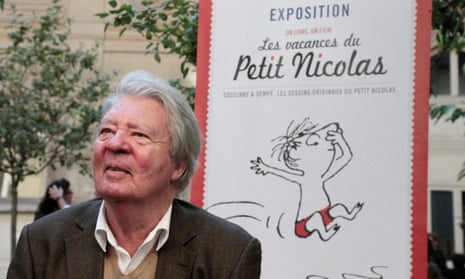Jean-Jacques Sempé, the celebrated French cartoonist who illustrated the children’s book series Le Petit Nicolas and produced more covers for the New Yorker magazine than any other artist, has died aged 89.
Sempé’s acclaimed cartoons often showed small figures set in vast urban landscapes or contemplating the enormity of nature amid trees or gardens. Drawn in delicate, soft lines, they were sometimes accompanied by a one-line gag – a deliberately gentle form of social commentary from an artist who had escaped a violent and difficult childhood near Bordeaux, but who described himself as an eternal optimist.
“Jean-Jacques Sempé had the elegance to always remain light and he had an eye for everything,” the French president, Emmanuel Macron, said in a tweet.
Le jazz, la tendre ironie, la délicatesse de l’intelligence. Du Petit Nicolas, en passant par Monsieur Lambert jusqu’aux promeneurs de Saint-Germain-des-Prés, Jean-Jacques Sempé avait l'élégance de toujours rester léger sans que rien ne lui échappe. pic.twitter.com/KOQPPIsn7A
— Emmanuel Macron (@EmmanuelMacron) August 11, 2022
“Sempé is France,” the Turkish Nobel laureate Orhan Pamuk told Paris Match earlier this year. “Everything is there: irony and tenderness.”
The French cartoonist Plantu said Sempé had used silence and blank spaces on the page to convey the notion of solitude in the vastness of the city.
Sempé’s work on the schoolboy saga Le Petit Nicolas was to prove one of the most successful children’s illustration series of the 20th century – presenting an idealised vision of childhood in 1950s France that became an international bestseller and raised questions about society’s nostalgia for an imagined bygone age.
“The Nicolas stories were a way to revisit the misery I endured while growing up while making sure everything came out just fine,” Sempé said in 2018. He created the character in 1959 with the cartooning legend René Goscinny of Asterix fame, whom he had met while working at a press agency. More than 15m copies of the book have been sold in 45 countries, and they have been adapted into a popular film and cartoon series.
Sempé was also celebrated for the artwork he produced for magazines. He illustrated more than 110 New Yorker covers, continued to work for Paris Match and had been exhibited in Paris.

Sempé died peacefully a few days before his 90th birthday, surrounded by his wife and friends, according to Marc Lecarpentier, his biographer and friend. Lecarpentier has in his writings about the cartoonist described Sempé as “an amused and disconcerted observer of the world around him” who examined the human soul by playing on the “disproportion of situations and roles” of his characters or of their thoughts and comments.
Sempé was born near Bordeaux in the village of Pessac in 1932. His paternity was a mystery that he said haunted him. “You don’t know who you are, what you’re built on,” he later said.
He lived in an abusive foster home before his mother took him back, only to subject him to further violence. He wanted to be a jazz pianist and dropped out of school at 14 before lying about his age to join the army. Army life did not agree with him, however, and he began selling drawings to Parisian newspapers.
after newsletter promotion

Though they went largely unnoticed, Sempé continued to sell drawings to newspapers to make ends meet, an early career he described as “horrible”.
It was only in 1978 when he was hired by the New Yorker that he found sustainable success. “I was almost 50 and for the first time in my life, I existed! I had finally found my family,” he said.
He was seen in France as revealing amusing and sometimes caustic truths about the world – making people smile without resorting to cruelty or mockery.
The kindness that Sempé showed the diminutive characters that he placed in an outsized world was in contrast to the misery of his own upbringing. “You never get over your childhood,” he said when well into his 80s, having avoided the subject for decades. “You try to sort things out, to make your memories prettier. But you never get over it.”
For many years Sempé refused to believe in his own talent, attributing what he had achieved to hard work and sacrifice. The artist said he could spend as long as three weeks not getting a single drawing right and that he was capable of “not bathing, not sleeping” to finish work on time.
Agence France-Presse contributed to this report
